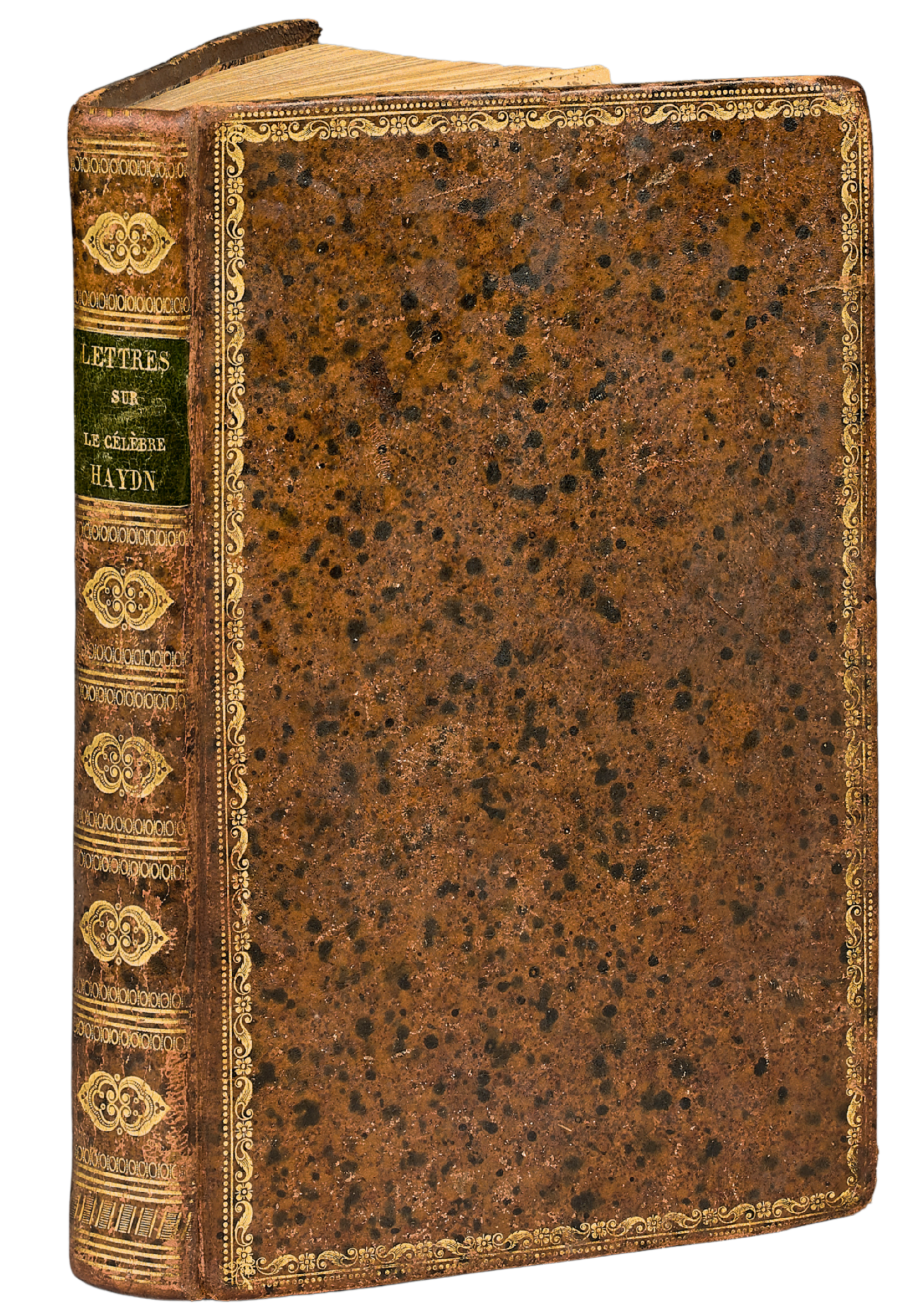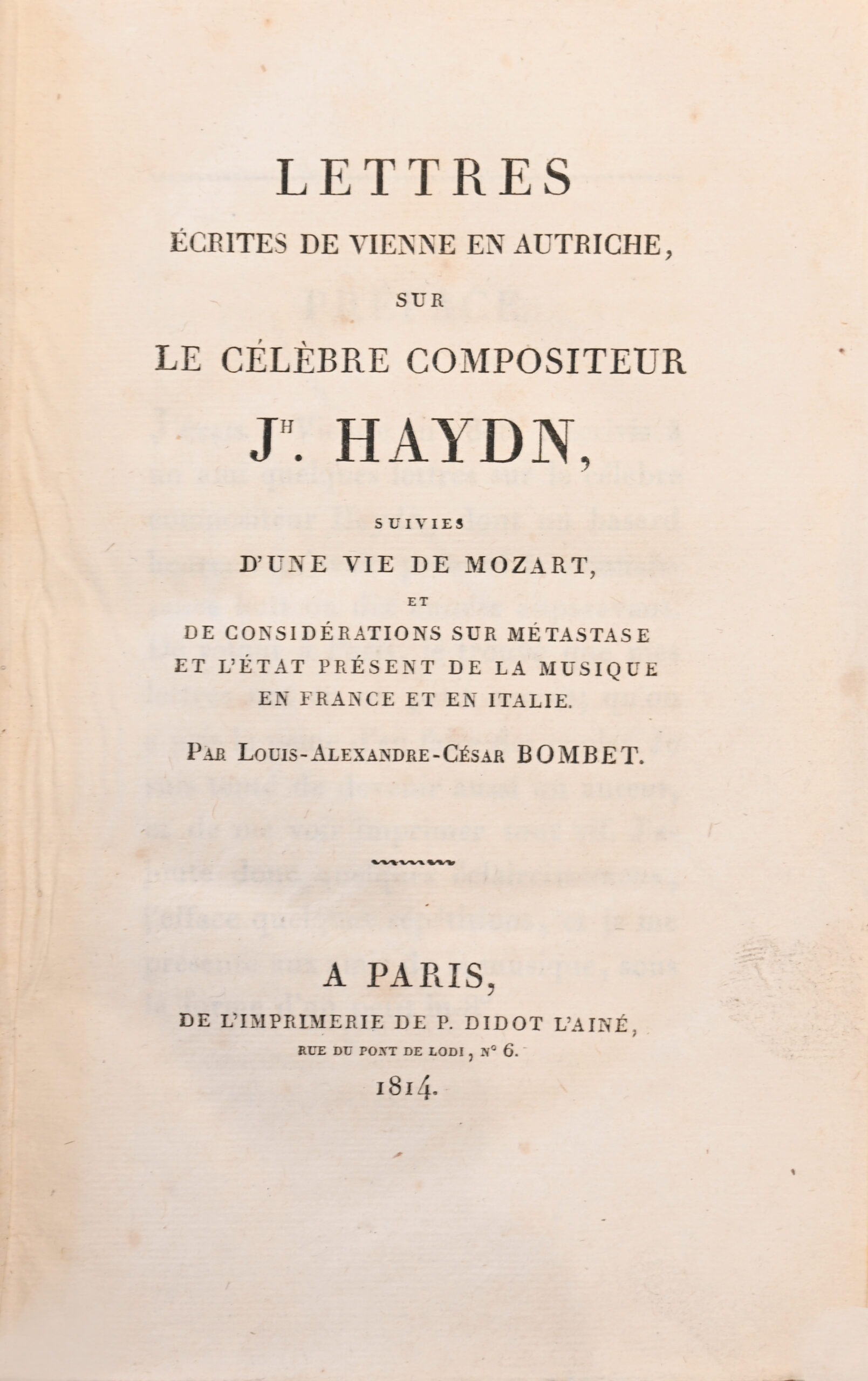Paris, Didot l’aîné, 1814.
8vo of 468 pp., some foxing. Full speckled brown calf, gilt fillet around covers, smooth spine richly gilt, green morocco title labels, gilt fillet on edges, marbled edges. Elegant full contemporary binding.
198 x 125 mm.
Rare first edition of the first work published by Stendhal.
Very rare, almost impossible to find in a full contemporary binding. Carteret mentions only two copies, both in contemporary half bindings.*
Carteret, II, 343–344; Clouzot, 256; Vicaire, Manuel de l’amateur de livres du XIXe siècle, III, 450–451.
A “very rare” work (Clouzot).
“These letters by the Italian Joseph Carpani, appearing here partly translated, partly arranged with original additions under the name of the first pseudonym of Henri Beyle, provoked energetic complaints from their author; the work reappeared three years later under the following title: Vies de Haydn, de Mozart et de Métastase, par Stendhal. These two works are of great rarity.” (Carteret)
“This work appeared under the pseudonym Louis-Alexandre-César Bombet. Giving himself over to chatter about the sources he used for his first book, the author does not hide that, in his opinion, the brilliance of his descriptions and the intelligence with which he sets out his thought should ensure his success. Taken as a whole, with its carefree borrowings from Giuseppe Carpani’s Haydine, from German works on Mozart, and from various Italian sources regarding Metastasio, the work only further establishes Stendhal’s great passion for Italy, for its artists and for its civilization. The music of Haydn and Mozart, the melodrama of Metastasio, are in his eyes the revenge of nature triumphing over prejudice; they exalt the joy of living, loving, and creating beyond daily adventures, which are always less than what a noble soul hopes for. The book acquired a somewhat ambiguous reputation, confirmed moreover by its author’s lack of prejudice. Carpani, informed of the plagiarism, sent two letters of protest to Bombet, letters postmarked from Vienna and elsewhere. Stendhal, continuing to uphold the fiction, sought to defend himself in a letter by giving various reasons, more or less debatable, but which rightly affirm the originality of the book with regard to the digressions on the value of art and its function in society, and on the manner of telling anecdotes.
Stendhal is one of the many pseudonyms, and the best known, of Henri Beyle, who, successively a cavalry officer, auditor to the Council of State, and administrator, ended his life as consul in Civita-Vecchia. His adopted homeland was Italy, where he spent many years and which he cherished so much that he wrote the following for his tomb inscription: “Arrigo Beyle, milanese.” The great passion of his mind was ideology, which Destutt de Tracy had brought into favor in his youth. Ideology was, according to Stendhal, the supreme science of life. “Thanks to ideology,” he wrote, “with nine pounds sterling and one hour a day for six months, we can reason as accurately as those great men (Hannibal, Caesar, etc.), and we lack only their experience and passions to equal them.” The type of novel that Stendhal created, says Paul Bourget, is a kind of novel resembling him and without analogue, analytical and ardent like himself, subtly ideological and intensely sensitive.”
“…This technique proceeds so directly from Beyle himself, from his irreducible duality, that it has remained inimitable and, in fact, imitated by no one… This solitude of Beyle as an artist is all the more striking because there exists a Stendhalian tradition that has continued to expand since that date of 1880 when the author of Le Rouge et le Noir had appointed his rendezvous with glory. ‘Stendhal, like Balzac, counts innumerable devotees,’ but it seems, as Anatole France wrote, that when one reads Beyle, it is Beyle one seeks, and one prefers the man he was to the most beautiful creations he left behind.”
Remarkable copy, clean and unwashed, preserved in its beautiful full contemporary binding.



